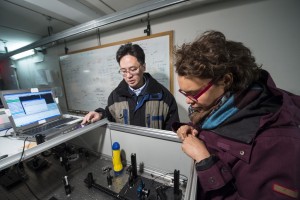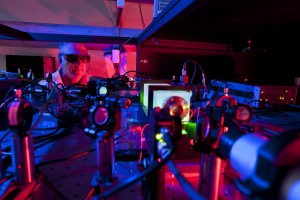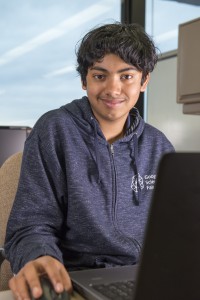
Pranav Sivakumar, a student at the Illinois Math and Science Academy, was recently recognized by President Barack Obama at White House Astronomy Night. Fermilab Ask-a-Scientist and Saturday Morning Physics talks were significant influences in his decision to pursue science. Photo: Reidar Hahn
Pranav Sivakumar, a junior at the Illinois Math and Science Academy, began attending Fermilab public lectures with his parents when he was in the fourth grade.
At first, as one might expect of an elementary school student, Sivakumar didn’t exactly know what was going on at Saturday Morning Physics and Ask-a-Scientist. But the scientists’ enthusiasm enthralled him.
“They really put in a lot of effort, going out of their way to teach. I caught some of that energy, and it’s stuck with me,” said Sivakumar, who is now 15 years old. “Fermilab has motivated me and focused me in the direction I wanted to go.”
This direction turned out to be astrophysics, specifically the study of gravitationally lensed quasars. Quasars are bright objects around black holes. When viewed from Earth, the light from gravitationally lensed quasars bends around a massive galaxy in front of them. This effect makes one quasar appear to be two or more quasars.
“Talking to Fermilab scientists, I realized how important gravitationally lensed quasars were in understanding dark matter and dark energy. This made me want to work with them,” Sivakumar said. Lensed quasars tell scientists about the rate of expansion of the universe, which can provide clues about enigmatic dark matter and dark energy.
For the Google Science Fair, a worldwide online science and technology competition among teens, Sivakumar developed algorithms to identify gravitationally lensed quasar candidates from data taken by the Sloan Digital Sky Survey. The algorithms help determine if two or more images of light are from a single lensed quasar or multiple quasars. With this project, he won the Virgin Galactic Pioneer Award and was one of 20 global finalists.
While working on this project, Sivakumar said he found mentors in two Fermilab scientists, Brian Nord and Chris Stoughton.
“The logic that he used to set up his algorithm is competitive with something that we would do,” said Nord, a research associate. “And he found a lensed quasar that was detected independently by our colleagues. The work that he’s done is something that requires persistence, focus and hard work.”
Soon after being recognized by the Google Science Fair, Sivakumar got a shout-out from President Obama in a speech at the White House Astronomy Night in October. Obama also mentioned how Fermilab’s public programs inspired Sivakumar’s work.
Sivakumar still looks to Fermilab scientists for inspiration and illumination. He recently visited the lab to continue working on an extension of his Google Science Fair quasar project with Fermilab astrophysicists, including Nord.
“We have a plan to work more with Pranav and see how far we can carry these algorithms,” Nord said.
“It’s all been fantastic,” Sivakumar said. “For the future, I want to continue in astrophysics. I’m really enjoying the way things are going.”
And when the President publicly praises you, who wouldn’t?
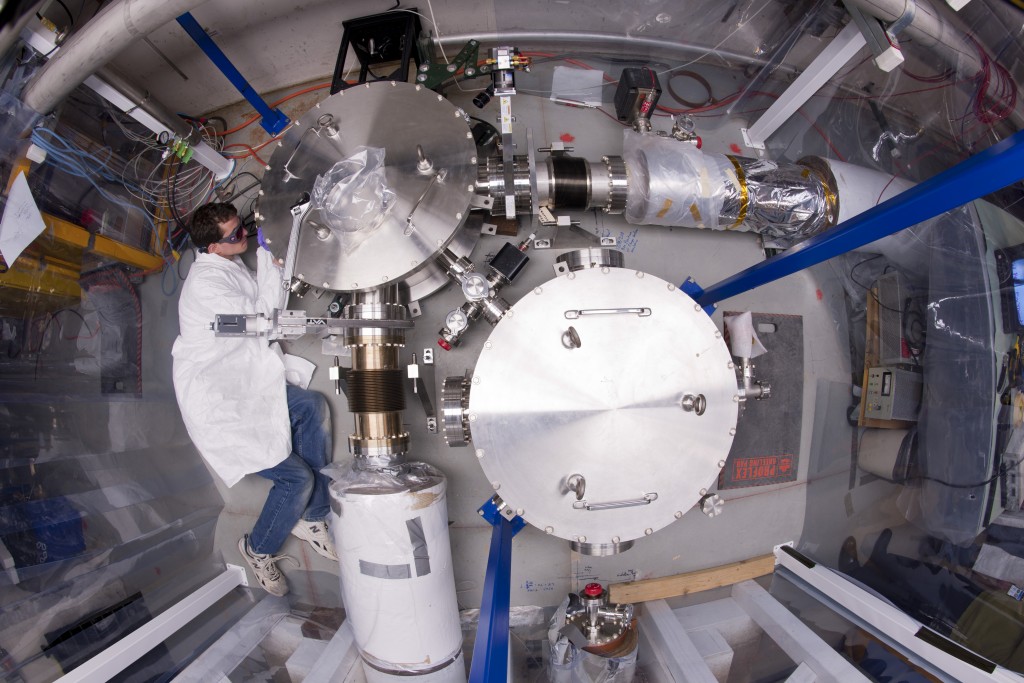
A member of the Holometer collaboration works on the sensitive space-time measuring device, located at Fermilab in Illinois. Photo: Fermilab
The extremely sensitive quantum-spacetime-measuring tool will serve as a template for scientific exploration in the years to come.
There has never been anything like the Holometer.
Based at the U.S. Department of Energy’s Fermilab in Illinois, the Holometer isn’t much to look at. It’s a small array of lasers and mirrors with a trailer for a control room. But the low-tech look of the device belies the fact that it is an unprecedentedly sensitive instrument, able to measure movements that last only a millionth of a second and distances that are a billionth of a billionth of a meter – a thousand times smaller than a single proton.
Our common sense, and the laws of physics, assumes that space and time are continuous. The Holometer challenges this assumption. We know that energy on the atomic level, for instance, is not continuous and comes in small, indivisible amounts. The Holometer was built to test if space and time behave the same way.
If they do, this would mean that everything is pixelated, like a digital image. When you zoom in far enough, you see that a digital image is not smooth, but made up of individual pixels. An image can only store as much data as the number of pixels allows. If the universe is similarly segmented, and hence more blurry than we think, then there would be a limit to the amount of information space-time can contain.
The main theory the Holometer was built to test was posited by Craig Hogan, a professor of astronomy and physics at the University of Chicago and the head of Fermilab’s Center for Particle Astrophysics. In a new result released this week after a year of data-taking, the Holometer collaboration has announced that it has ruled out Hogan’s theory of a pixelated universe to a high level of statistical significance. This means the Holometer did not detect the amount of correlated holographic noise – quantum jitter – that this particular model of space-time predicts.
But as Hogan emphasizes, that’s just one theory, and with the Holometer, this team of scientists has proven that space-time can be probed at an unprecedented level.
“This is just the beginning of the story,” Hogan said. “We’ve developed a new way of studying space and time that we didn’t have before. We weren’t even sure we could attain the sensitivity we did.”
The Holometer is a deceptively simple device. It uses a pair of laser interferometers placed close to one another, each sending a one-kilowatt beam of light through a beam splitter and down two perpendicular arms, 40 meters each. The light is then reflected back into the beam splitter where the two beams recombine. If no motion has occurred, then the recombined beam will be the same as the original beam. But if fluctuations in brightness are observed, researchers will then analyze these fluctuations to see if the splitter is moving in a certain way, being carried along on a jitter of space itself.
According to Fermilab’s Aaron Chou, project manager of the Holometer experiment, the collaboration looked to the work done to design other, similar instruments, such as the one used in the Laser Interferometer Gravitational-Wave Observatory (LIGO) experiment. Chou said that once the Holometer team realized that this technology could be used to study the quantum fluctuation they were after, the work of other collaborations using laser interferometers (including LIGO) was invaluable.
“No one has ever applied this technology in this way before,” Chou said. “A small team, mostly students, built an instrument nearly as sensitive as LIGO’s to look for something completely different.”
The challenge for researchers using the Holometer is to eliminate all other sources of movement until they are left with a fluctuation they cannot explain. According to Fermilab’s Chris Stoughton, scientist on the Holometer experiment, the process of taking data was one of constantly adjusting the machine to remove more noise.
“You would run the machine for a while, take data, and then try to get rid of all the fluctuation you could see before running it again,” he said. “The origin of the phenomenon we’re looking for is a billion billion times smaller than a proton, and the Holometer is extremely sensitive, so it picks up a lot of outside sources, such as wind and traffic.”
If the Holometer were to see holographic noise that researchers could not eliminate, it might be detecting noise that is intrinsic to space-time, which may mean that information in our universe could actually be encoded in tiny packets in two dimensions.
The fact that the Holometer ruled out his theory to a high level of significance proves that it can probe time and space at previously unimagined scales, Hogan said. It also proves that if this quantum jitter exists, it is either much smaller than the Holometer can detect, or is moving in directions the current instrument is not configured to observe.
So what’s next? Hogan said the Holometer team will continue to take and analyze data, and will publish more general and more sensitive studies of holographic noise. The collaboration already released a result related to the study of gravitational waves.
And Hogan is already putting forth a new model of holographic structure that would require similar instruments of the same sensitivity, but different configurations sensitive to the rotation of space. The Holometer, he said, will serve as a template for an entirely new field of experimental science.
“It’s new technology, and the Holometer is just the first example of a new way of studying exotic correlations,” Hogan said. “It is just the first glimpse through a newly invented microscope.”
The Holometer experiment is supported by funding from the U.S. Department of Energy Office of Science. The Holometer collaboration includes scientists from Fermilab, the University of Chicago, the Massachusetts Institute of Technology and the University of Michigan.
- Aaron Chou, project manager of the Holometer, and grad student Brittany Kamai work on the laser beam that powers the Holometer. Photo: Fermilab
- A scientist works on the laser interferometer at the heart of the Holometer experiment. Photo: Fermilab
See other science results from Fermilab.
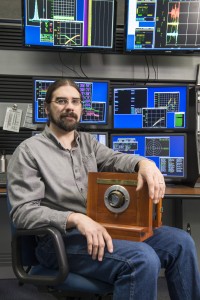
When Chris Olsen isn’t working in the Main Control Room, he’s attending to one of his many hobbies, including old photography. Photo: Reidar Hahn
How long have you been at Fermilab?
Almost 16 years.
What path led you here?
I have a degree in history. After working a couple of years outside of the lab — at a hardware store, as a prototyping machinist, driving a school bus — I decided I wanted to do something else. I’d worked at the campus particle accelerator lab all four years of college and had built a couple particle accelerators at home. I brought my own cyclotron to my interview here. I think they hired me to keep an eye on me.
What is your typical day here like?
Operators run the machines to provide beam as needed to the experiments. It’s a very catchall job. If anything goes wrong, we’re the first line of defense. At the beginning of a shift, we meet with the off-going crew chief and read a logbook for instructions. Then we go into the control room to get more specific information for whatever machine we’re taking over. Then we’ll sit there, answer phones and tune the machines. If something trips off we’ll either go and fix it or see if one of the techs can fix it.
What’s the most exciting part of your job?
I enjoy the interaction with people from all over. And I enjoy talking to tours. I got to speak with the remaining crew of the Enola Gay when they came through. As a historian, that was amazing. I also enjoy going out in the field to fix stuff. My forte is hardware.
You recently had some photographs in an employee art show. Can you tell me about your photography?
I’m a student of 19th-century photography. I do daguerreotypes and wet plate collodion, which are the two first photographic processes that were commercially successful. Being an operator gives me the very special privilege of taking my camera equipment into the accelerator complex and using this 150-year-old process to take pictures of it. I also do backstage concert photography and take pictures of Civil War reenactors. I used to do my own 18th-century reenactment, so I give these pictures to the Civil War reenactors as gifts.
Is there anything people might not know about you?
My friends call me the man of a thousand hobbies. I build medieval crossbows. I teach woodworking and blacksmithing at Four Winds Waldorf School. My kids go there. I have a hundred-year-old sock knitting machine that I make socks with. I’m restoring a 1923 Model T. Working here has actually allowed me to do all this. Talking with colleagues has expanded my creativity and artistic side.
Hyde Park Herald, Nov. 18, 2015: Mayor Rahm Emanuel and University of Chicago President Robert Zimmer kicked off an event titled “The University of Chicago and Affiliated Laboratories: Powerful Partners in Transformative Science” on Friday, Nov. 13, by pointing to the continued prominence of the university as a national leader is scientific developments.
Scientists have made the first-ever calculation of a prediction involving the decay of certain matter and antimatter particles.
From Physics, Nov. 23, 2015: The mass of the recently discovered Higgs particle is one of the greatest mysteries in present-day particle physics. While much larger than the mass of most known elementary particles, it is far smaller than other energy scales. Within our current understanding of quantum mechanics and relativity, this disparity is puzzling and is referred to as the hierarchy or naturalness problem. One popular explanation is provided by a hypothesized new symmetry of nature, supersymmetry.

